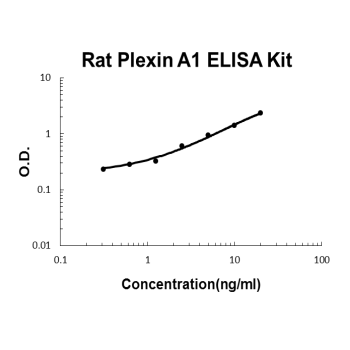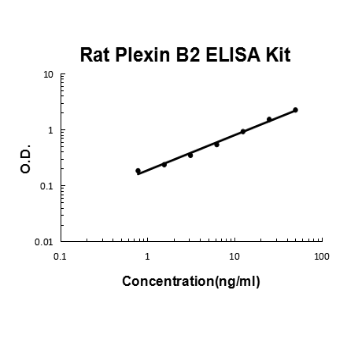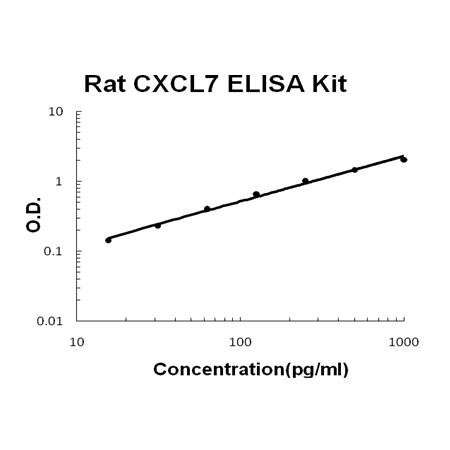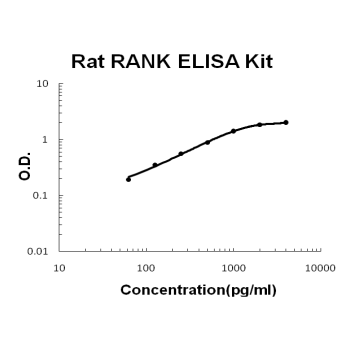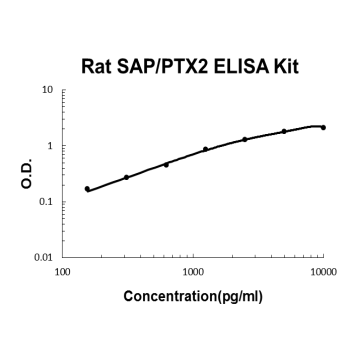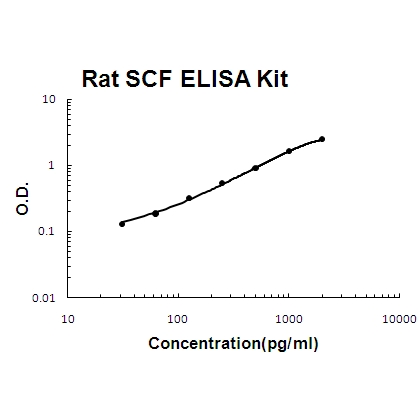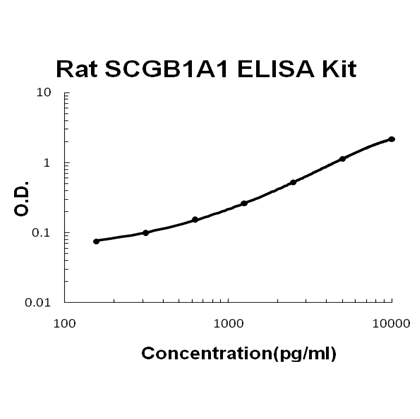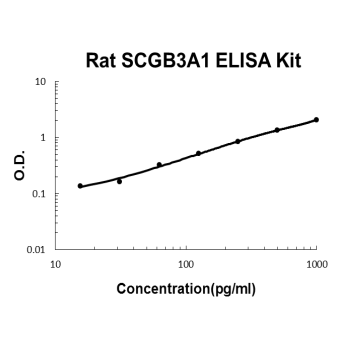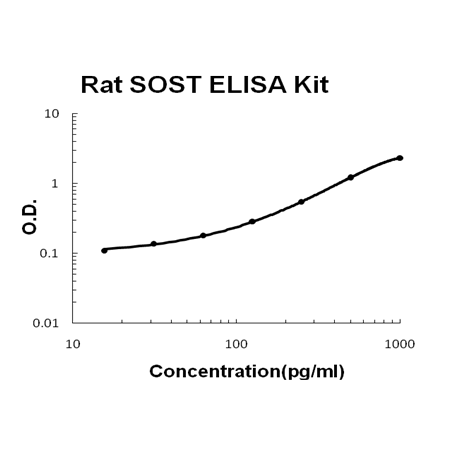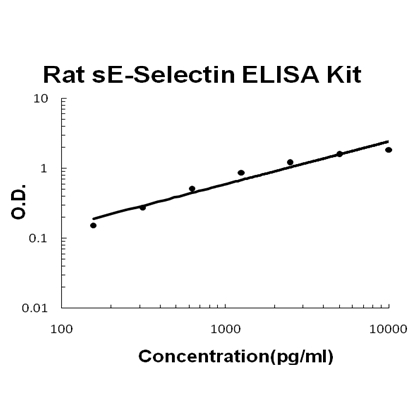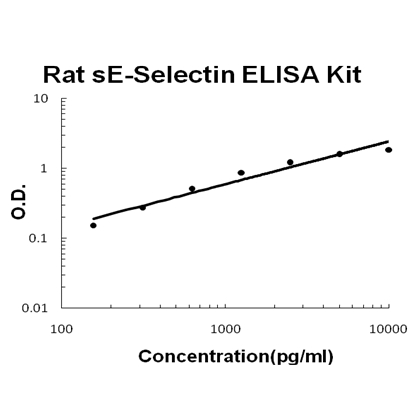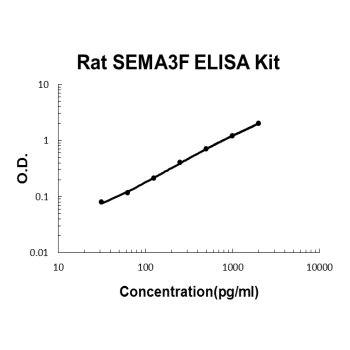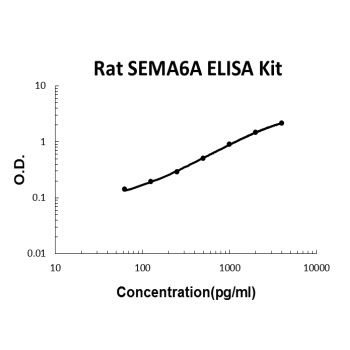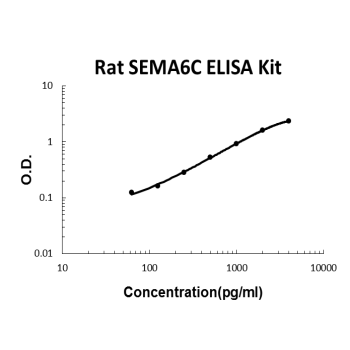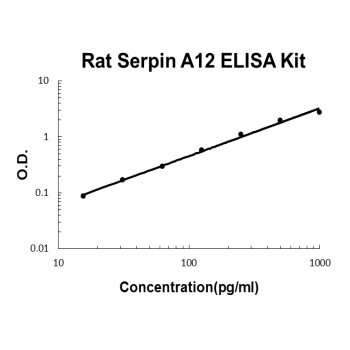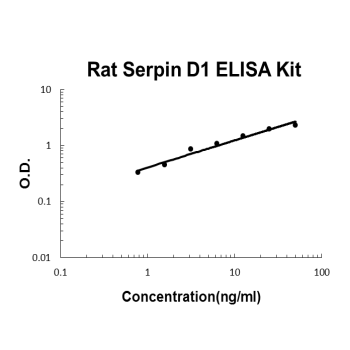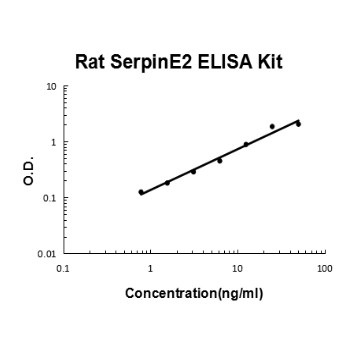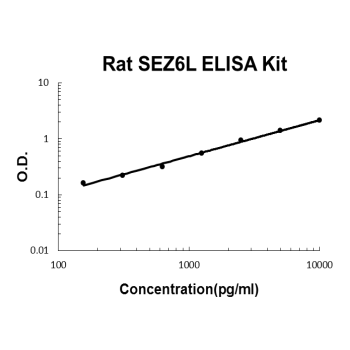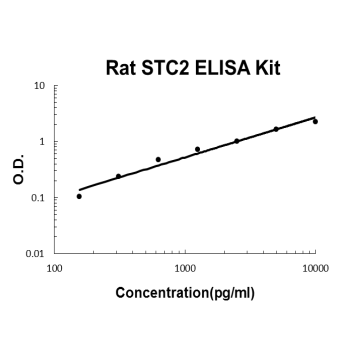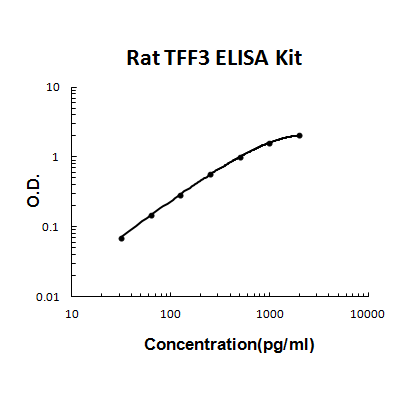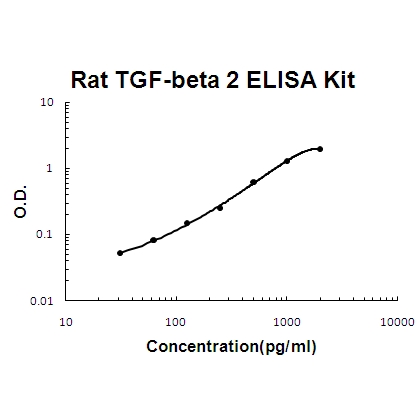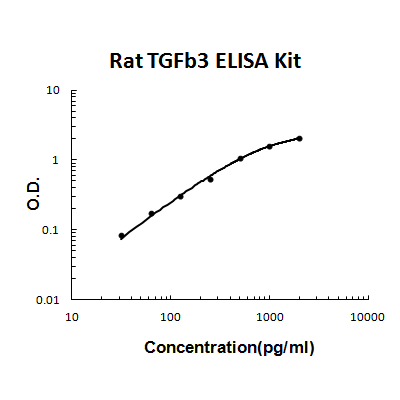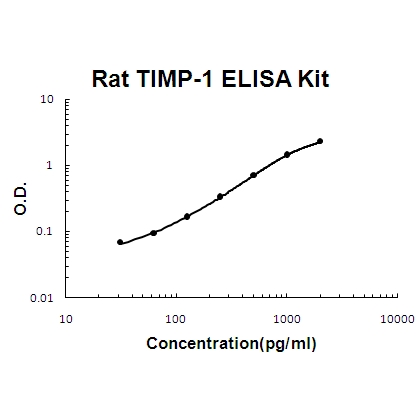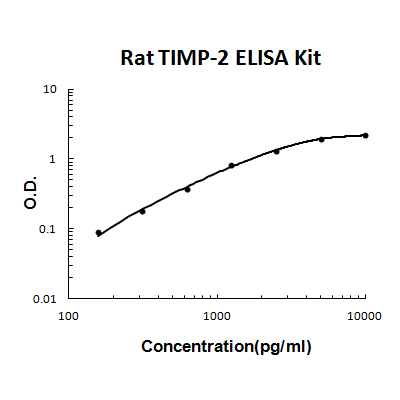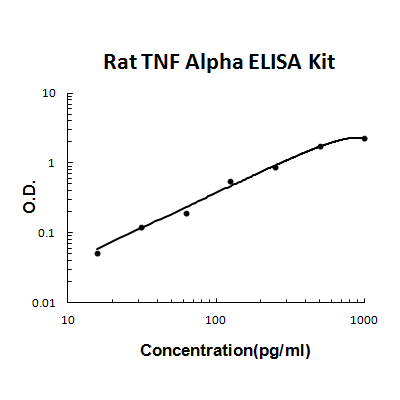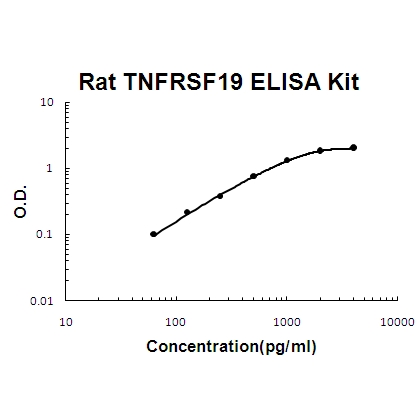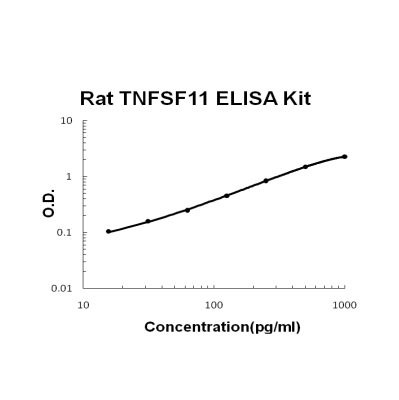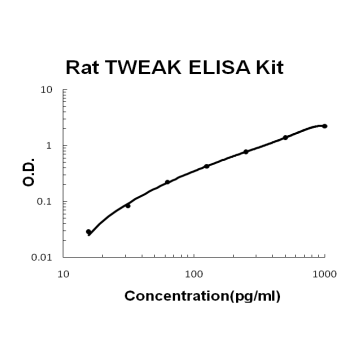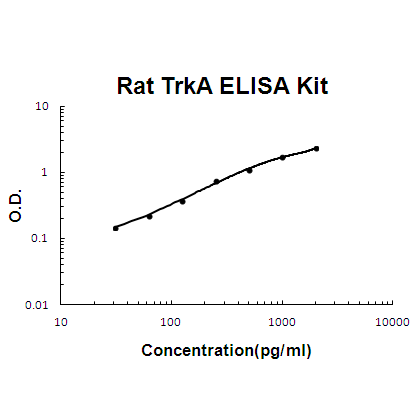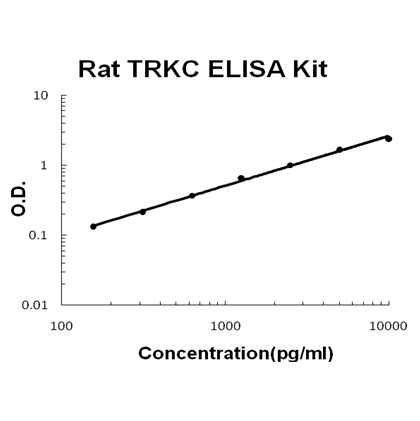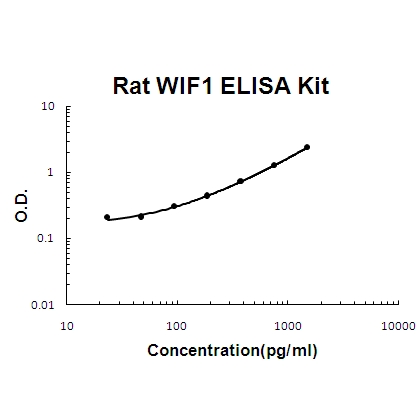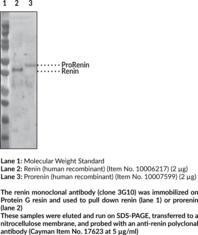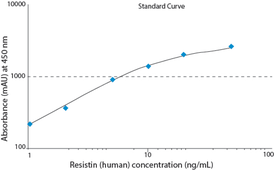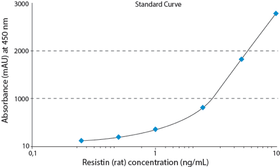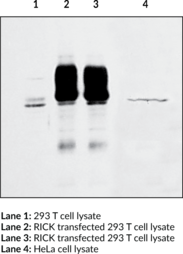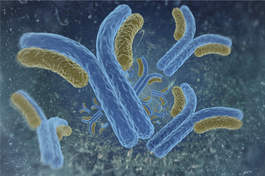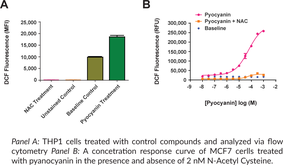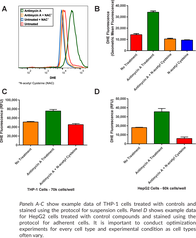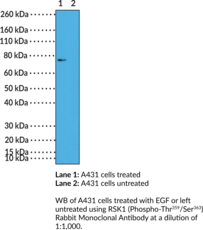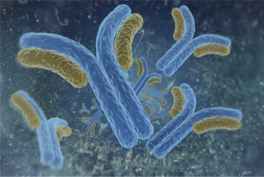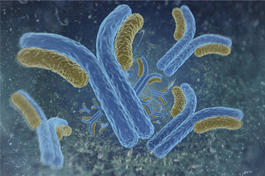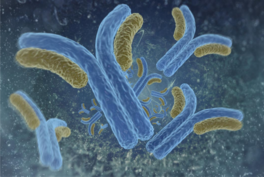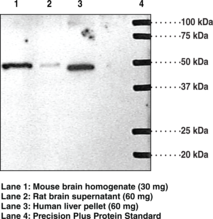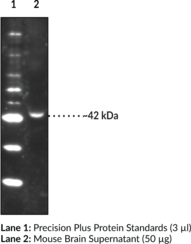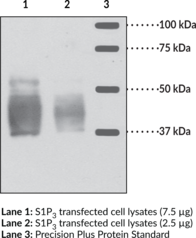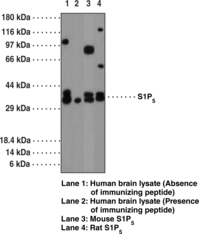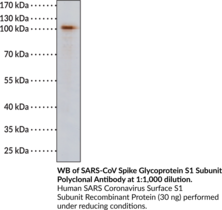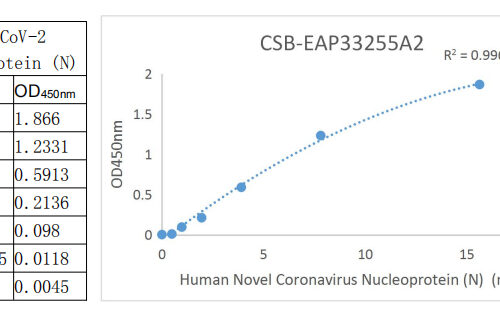ELISA Kits
Showing 3151–3300 of 3623 results
-
For quantitative detection of rat Plexin A1 in cell culture supernates, serum and plasma (heparin, EDTA).
Brand:Boster BioSKU:EK1819Available on backorder
For quantitative detection of rat Plexin B2 in cell culture supernates, serum and plasma (heparin, EDTA).
Brand:Boster BioSKU:EK1883Available on backorder
For Quantitative Detection of rat CXCL7 in cell culture supernates, serum and plasma (heparin, EDTA).
Brand:Boster BioSKU:EK0731Available on backorder
For quantitative detection of rat RAGE in cell culture supernates, cell lysates, serum and plasma (heparin, EDTA).
Brand:Boster BioSKU:EK0971Available on backorder
Brand:Boster BioSKU:EK1281Available on backorder
The Fast version of Picokine ELISA kits, assay takes less than 1.5 hours. Detect Rat Rank/TNFRSF11A with <10pg/ml sensitivity. Format: 96-well plate with removable strips. Compatible samples: cell culture supernates and serum. This is a TMB colorimetric sandwich ELISA kit with short assay time and fast experiment set up. Rank/TNFRSF11A tissue specificity:
Brand:Boster BioSKU:FEK1281Available on backorder
For quantitative detection of rat Rantes in cell culture supernates, serum and plasma(heparin, EDTA, citrate).
Brand:Boster BioSKU:EK0496Available on backorder
Brand:Boster BioSKU:EK1836Available on backorder
For quantitative detection of rat S100B in cell culture supernates, serum and plasma(heparin, EDTA).
Brand:Boster BioSKU:EK1165Available on backorder
For quantitative detection of rat SAP in cell culture supernates, cell lysates, serum and plasma (heparin, EDTA).
Brand:Boster BioSKU:EK1209Available on backorder
Brand:Boster BioSKU:EK0508Available on backorder
For Quantitative Detection of rat SCGB1A1 in cell culture supernates, serum, plasma (heparin, EDTA) and urine.
Brand:Boster BioSKU:EK1636Available on backorder
Sandwich High Sensitivity ELISA kit for Quantitative The Fast version of Picokine ELISA kits, assay takes less than 1.5 hours. Detection of rat SCGB1A1. 96wells/kit, with removable strips.
Brand:Boster BioSKU:FEK1636Available on backorder
For quantitative detection of rat SCGB3A1 in cell culture supernates, serum and plasma (heparin, EDTA).
Brand:Boster BioSKU:EK1994Available on backorder
For quantitative detection of rat Sclerostin in cell culture supernates, cell lysates, serum and plasma (heparin, EDTA).
Brand:Boster BioSKU:EK1565Available on backorder
For quantitative detection of rat soluble E-Selectin in cell culture supernates, serum and plasma(heparin, citrate).
Brand:Boster BioSKU:EK0936Available on backorder
The Fast version of Picokine ELISA kits, assay takes less than 1.5 hours. Detect Rat E Selectin/SELE with <10pg/ml sensitivity. Format: 96-well plate with removable strips. Compatible samples: cell culture supernates, serum and plasma(heparin, citrate). This is a TMB colorimetric sandwich ELISA kit with short assay time and fast experiment set up. E Selectin/SELE tissue specificity:
Brand:Boster BioSKU:FEK0936Available on backorder
For quantitative detection of rat SEMA3F in cell culture supernates, serum and plasma (heparin, EDTA, citrate).
Brand:Boster BioSKU:EK1735Available on backorder
For quantitative detection of rat SEMA4G in cell culture supernates, serum and plasma (heparin, EDTA, citrate).
Brand:Boster BioSKU:EK2055Available on backorder
For quantitative detection of rat SEMA6A in cell culture supernates, serum and plasma (heparin, EDTA, citrate).
Brand:Boster BioSKU:EK2057Available on backorder
For quantitative detection of rat SEMA6C in cell culture supernates, serum and plasma (heparin, EDTA, citrate).
Brand:Boster BioSKU:EK2059Available on backorder
For quantitative detection of rat Serpin A12 in cell culture supernates, serum and plasma (heparin, EDTA).
Brand:Boster BioSKU:EK1741Available on backorder
For quantitative detection of rat Serpin D1 in cell culture supernates, serum and plasma (EDTA, citrate) and urine.
Brand:Boster BioSKU:EK1970Available on backorder
For quantitative detection of rat SerpinE2 in cell culture supernates, serum and plasma (heparin, EDTA, citrate) and urine.
Brand:Boster BioSKU:EK1886Available on backorder
Brand:Boster BioSKU:EK1832Available on backorder
For quantitative detection of rat soluble L-Selectin in cell culture supernates, cell lysates, serum and plasma (heparin, EDTA).
Brand:Boster BioSKU:EK0937Available on backorder
Brand:Boster BioSKU:EK1937Available on backorder
Brand:Boster BioSKU:EK1995Available on backorder
Brand:Boster BioSKU:EK1683Available on backorder
For Quantitative Detection of rat TFF3 in cell culture supernates, serum and plasma (heparin, EDTA).
Brand:Boster BioSKU:EK1679Available on backorder
For quantitative detection of activated rat TGF beta 1 in cell culture supernates, serum, plasma(EDTA) and urine.
Brand:Boster BioSKU:EK0514Available on backorder
For quantitative detection of activated rat TGF-beta 2 in cell culture supernates, serum and plasma(heparin, EDTA, citrate).
Brand:Boster BioSKU:EK0982Available on backorder
For quantitative detection of activated rat TGF-beta 3 in cell culture supernates, serum, plasma(EDTA) and urine.
Brand:Boster BioSKU:EK1105Available on backorder
For quantitative detection of rat TIMP-1 in cell culture supernates, cell lysates, serum and plasma (heparin, EDTA).
Brand:Boster BioSKU:EK0583Available on backorder
For quantitative detection of rat TIMP-2 in cell culture supernates, cell lysates, serum and plasma (heparin, EDTA).
Brand:Boster BioSKU:EK1302Available on backorder
For quantitative detection of rat TNF alpha in cell culture supernates, cell lysates, serum and plasma (heparin, EDTA).
Brand:Boster BioSKU:EK0526Available on backorder
For quantitative detection of rat TNFRSF19 in cell culture supernates, cell lysates, serum and plasma (heparin, EDTA).
Brand:Boster BioSKU:EK1607Available on backorder
For quantitative detection of rat TNFSF11 in cell culture supernates, cell lysates, serum and plasma (heparin, EDTA).
Brand:Boster BioSKU:EK1559Available on backorder
For quantitative detection of rat TNFSF12 in cell culture supernates, cell lysates, serum and plasma (heparin, EDTA).
Brand:Boster BioSKU:EK1177Available on backorder
For quantitative detection of rat TNFSF14 in cell culture supernates, cell lysates, serum and plasma (heparin, EDTA).
Brand:Boster BioSKU:EK1575Available on backorder
Brand:Boster BioSKU:EK0847Available on backorder
For quantitative detection of rat TRKB in cell culture supernates, cell lysates, serum and plasma (heparin, EDTA).
Brand:Boster BioSKU:EK1596Available on backorder
Brand:Boster BioSKU:EK1660Available on backorder
For quantitative detection of rat VE-Cadherin/CD144 in cell culture supernates, serum and plasma (heparin, EDTA).
Brand:Boster BioSKU:EK1916Available on backorder
For quantitative detection of rat VEGF in cell culture supernates, serum and plasma(heparin, EDTA, citrate).
Brand:Boster BioSKU:EK0540Available on backorder
Brand:Boster BioSKU:EK1347Available on backorder
For quantitative detection of rat WIF1 in cell culture supernates, cell lysates, serum and plasma (heparin, EDTA).
Brand:Boster BioSKU:EK1564Available on backorder
For quantitative detection of rat WISP1 in cell culture supernates, serum and plasma (heparin, EDTA).
Brand:Boster BioSKU:EK1588Available on backorder
Brand:CaymanSKU:700992 - 6 mgAvailable on backorder
Brand:CaymanSKU:10006870 - 1 eaAvailable on backorder
Renin is an aspartyl protease of approximately 40 kDa that is released in active form from renal juxtaglomerular cells in response to sodium depletion, decreased blood volume and blood pressure, and b-adrenergic stimulation.{12331,13007,12970} Renin catalyzes the initial and rate limiting step in the renin-angiotensin system (RAS) pathway, converting angiotensinogen into angiotensin I. Angiotensin Converting Enzyme (ACE) subsequently converts angiotensin I to angiotensin II, which is a potent vasoconstrictor. Cayman’s Renin Inhibitor Screening Assay Kit provides a convenient assay in a 96-well format for evaluating human renin inhibitors. The assay utilizes a renin-based synthetic peptide substrate which incorporates the fluorophore EDANS at one end and an EDAN-quenching molecule (Dabcyl) at the other end.{12969} After cleavage by renin, the peptide-EDANS product is released yielding bright fluorescence which can be easily analyzed using excitation wavelengths of 335-345 nm and emission wavelengths of 485-510 nm. The assay kit includes recombinant human renin (sufficient for 100 reactions), substrate, buffers, and complete instructions.
Brand:CaymanSKU:10006270 - 96 wellsAvailable on backorder
Cayman’s Renin Monoclonal Antibody (Clone 3G10) is directed against the full length renin (human recombinant) protein (Item No. 10006217). Renin is an aspartyl protease of approximately 40 kDa produced in the kidney by juxtaglomerular cells of the macula densa.{12331} Renin converts angiotensinogen into angiotensin I, activating a major arm of renal sodium and volume auto-regulation. Native human renin is a glycoprotein derived from preprorenin by sequential cleavage. The first cleavage releases the signal peptide (amino acids 1-23), forming the prorenin (44 kDa). The second cleavage removes the propeptide (amino acids 24-66), forming the functional renin protein (40 kDa). This antibody detects both the active renin and prorenin.
Brand:CaymanSKU:17624 - 200 µgAvailable on backorder
Resistin is a peptide hormone belonging to the class of cysteine-rich secreted proteins termed the RELM family, and is also described as ADSF (Adipose Tissue-Specific Secretory Factor) and FIZZ3 (Found in Inflammatory Zone). Resistin impairs glucose tolerance and insulin action in mice and also inhibits adipogenesis of murine 3T3-L1 cells. Therefore, resistin has been proposed as an adipocyte secreted factor linking obesity and type 2 diabetes. This Enzyme Immunometric Assay (EIA) is based on a double-antibody sandwich technique for quantification of human resistin. [Bertin Catalog No. A05177]
Brand:CaymanSKU:10007610 - 96 wellsAvailable on backorder
Resistin is a peptide hormone belonging to the class of cysteine-rich secreted proteins termed the RELM family, and is also described as ADSF (Adipose Tissue-Specific Secretory Factor) and FIZZ3 (Found in Inflammatory Zone). Resistin impairs glucose tolerance and insulin action in mice and also inhibits adipogenesis of murine 3T3-L1 cells. Therefore, resistin has been proposed as an adipocyte secreted factor linking obesity and type 2 diabetes. This Enzyme Immunometric Assay (EIA) is based on a double-antibody sandwich technique for quantification of rat resistin. [Bertin Catalog No. A05179]
Brand:CaymanSKU:10007612 - 96 wellsAvailable on backorder
Brand:CaymanSKU:400382 - 100 dtnAvailable on backorder
Brand:CaymanSKU:400382 - 500 dtnAvailable on backorder
Cayman’s Resolvin D1 (RvD1) ELISA Kit is a competitive assay that can be used for quantification of RvD1 (17(S)-Resolvin D1) in plasma, serum, and cell culture supernatants. The assay has a range from 3.3-2,000 pg/ml and a sensitivity (80% B/B0) of approximately 15 pg/ml.
Brand:CaymanSKU:500380 - 480 solid wellsAvailable on backorder
Cayman’s Resolvin D1 (RvD1) ELISA Kit is a competitive assay that can be used for quantification of RvD1 (17(S)-Resolvin D1) in plasma, serum, and cell culture supernatants. The assay has a range from 3.3-2,000 pg/ml and a sensitivity (80% B/B0) of approximately 15 pg/ml.
Brand:CaymanSKU:500380 - 480 strip wellsAvailable on backorder
Cayman’s Resolvin D1 (RvD1) ELISA Kit is a competitive assay that can be used for quantification of RvD1 (17(S)-Resolvin D1) in plasma, serum, and cell culture supernatants. The assay has a range from 3.3-2,000 pg/ml and a sensitivity (80% B/B0) of approximately 15 pg/ml.
Brand:CaymanSKU:500380 - 96 solid wellsAvailable on backorder
Cayman’s Resolvin D1 (RvD1) ELISA Kit is a competitive assay that can be used for quantification of RvD1 (17(S)-Resolvin D1) in plasma, serum, and cell culture supernatants. The assay has a range from 3.3-2,000 pg/ml and a sensitivity (80% B/B0) of approximately 15 pg/ml.
Brand:CaymanSKU:500380 - 96 strip wellsAvailable on backorder
Brand:CaymanSKU:400384 - 100 ngAvailable on backorder
Brand:CaymanSKU:401122 - 100 dtnAvailable on backorder
Brand:CaymanSKU:401122 - 500 dtnAvailable on backorder
Resolvin D2 (RvD2) is produced physiologically from the sequential oxygenation of docosahexaenoic acid (DHA) by 15- and 5-lipoxygenases. RvD2 reduces polymorphonuclear leukocyte transendothelial migration, the earliest event in acute inflammation, by ~70% at doses as low as 10 pg in the mouse model of peritonitis. In the rat model of burn injury and sepsis, RvD2 restores defective neutrophil motility and dramatically increases survival at doses of 8-10 ng/rat. Resolvins also enhance bacterial clearance by phagocytosis and have been shown to synergistically enhance certain antibiotics. Cayman’s Resolvin D2 ELISA Kit is a competitive assay that can be used for quantification of RvD2. Due to the number and variation of potential sample types, this assay has been validated in Cayman’s ELISA Buffer (Item No. 400060) diluted to 1X (0.1 M potassium phosphate containing 0.1% BSA, 400 mM sodium chloride, 1 mM EDTA, and 0.01% sodium azide), human plasma, and human serum. The assay has a range from 1.6-1,000 pg/ml and a sensitivity (80% B/B0) of approximately 10 pg/ml.
Brand:CaymanSKU:501120 - 480 solid wellsAvailable on backorder
Resolvin D2 (RvD2) is produced physiologically from the sequential oxygenation of docosahexaenoic acid (DHA) by 15- and 5-lipoxygenases. RvD2 reduces polymorphonuclear leukocyte transendothelial migration, the earliest event in acute inflammation, by ~70% at doses as low as 10 pg in the mouse model of peritonitis. In the rat model of burn injury and sepsis, RvD2 restores defective neutrophil motility and dramatically increases survival at doses of 8-10 ng/rat. Resolvins also enhance bacterial clearance by phagocytosis and have been shown to synergistically enhance certain antibiotics. Cayman’s Resolvin D2 ELISA Kit is a competitive assay that can be used for quantification of RvD2. Due to the number and variation of potential sample types, this assay has been validated in Cayman’s ELISA Buffer (Item No. 400060) diluted to 1X (0.1 M potassium phosphate containing 0.1% BSA, 400 mM sodium chloride, 1 mM EDTA, and 0.01% sodium azide), human plasma, and human serum. The assay has a range from 1.6-1,000 pg/ml and a sensitivity (80% B/B0) of approximately 10 pg/ml.
Brand:CaymanSKU:501120 - 480 strip wellsAvailable on backorder
Resolvin D2 (RvD2) is produced physiologically from the sequential oxygenation of docosahexaenoic acid (DHA) by 15- and 5-lipoxygenases. RvD2 reduces polymorphonuclear leukocyte transendothelial migration, the earliest event in acute inflammation, by ~70% at doses as low as 10 pg in the mouse model of peritonitis. In the rat model of burn injury and sepsis, RvD2 restores defective neutrophil motility and dramatically increases survival at doses of 8-10 ng/rat. Resolvins also enhance bacterial clearance by phagocytosis and have been shown to synergistically enhance certain antibiotics. Cayman’s Resolvin D2 ELISA Kit is a competitive assay that can be used for quantification of RvD2. Due to the number and variation of potential sample types, this assay has been validated in Cayman’s ELISA Buffer (Item No. 400060) diluted to 1X (0.1 M potassium phosphate containing 0.1% BSA, 400 mM sodium chloride, 1 mM EDTA, and 0.01% sodium azide), human plasma, and human serum. The assay has a range from 1.6-1,000 pg/ml and a sensitivity (80% B/B0) of approximately 10 pg/ml.
Brand:CaymanSKU:501120 - 96 solid wellsAvailable on backorder
Resolvin D2 (RvD2) is produced physiologically from the sequential oxygenation of docosahexaenoic acid (DHA) by 15- and 5-lipoxygenases. RvD2 reduces polymorphonuclear leukocyte transendothelial migration, the earliest event in acute inflammation, by ~70% at doses as low as 10 pg in the mouse model of peritonitis. In the rat model of burn injury and sepsis, RvD2 restores defective neutrophil motility and dramatically increases survival at doses of 8-10 ng/rat. Resolvins also enhance bacterial clearance by phagocytosis and have been shown to synergistically enhance certain antibiotics. Cayman’s Resolvin D2 ELISA Kit is a competitive assay that can be used for quantification of RvD2. Due to the number and variation of potential sample types, this assay has been validated in Cayman’s ELISA Buffer (Item No. 400060) diluted to 1X (0.1 M potassium phosphate containing 0.1% BSA, 400 mM sodium chloride, 1 mM EDTA, and 0.01% sodium azide), human plasma, and human serum. The assay has a range from 1.6-1,000 pg/ml and a sensitivity (80% B/B0) of approximately 10 pg/ml.
Brand:CaymanSKU:501120 - 96 strip wellsAvailable on backorder
Brand:CaymanSKU:401124 - 50 ngAvailable on backorder
The p90 ribosomal S6 kinases (RSKs) 1-4 are downstream members of the extracellular signal-regulated kinase (ERK)/MAPK cascade. The loss of RSK2 activity in humans leads to Coffin-Lowry syndrome, which is characterized by mental retardation and growth deficits.{14437} Recent work suggests that RSK2 exerts a tonic regulation on G protein-coupled signaling.{14438}
Brand:CaymanSKU:10009411 - 1 eaAvailable on backorder
Apoptosis is mediated by death domain (DD) and/or caspase recruitment domain (CARD) containing molecules and a caspase family of proteases. The DD-containing serine/threonine kinase RIP regulates Fas-induced apoptosis. A novel CARD-containing serine/threonine kinase that regulates apoptosis was identified and designated RICK for RIP-like interacting CLARP kinase.{7167} RICK contains an N-terminal kinase catalytic domain and a C-terminal CARD domain. The RICK kinase domain has high sequence homology to that of RIP. Overexpression of RICK promotes the activation of caspase-8 and Fas-induced apoptosis. RICK represents a novel kinase that regulates Fas-induced apoptosis. The mRNA for RICK is expressed in multiple human tissues.{7167} RICK interacts with several Nod and T-cell receptor proteins and thereby confers signal transduction for innate and adaptive immune system responses.{12843}
Brand:CaymanSKU:160785 - 500 µlAvailable on backorder
Retinoic acid-inducible gene I (RIG-I), also known as DDX58, is a cytosolic DExD/H-box RNA helicase and an immune sensing receptor encoded by DDX58 in humans.{48287} It is composed of a C-terminal repressor domain, a central RNA helicase domain, and two N-terminal caspase recruitment domains (CARDs).{48287,48288} Following recognition of viral dsRNA by the C-terminal and helicase domains, the helicase domain induces an ATP-dependent conformational change, allowing for interaction of the CARD domains with mitochondrial antiviral-signaling protein (MAVS) and induction of a type I interferon (IFN) response.{48287,48288,48289} RIG-I levels are elevated in the epidermis of patients with psoriasis.{48288} DDX58 expression is decreased in tumor tissues from patients with hepatocellular carcinoma (HCC) compared to nontumor hepatic tissue, and low DDX58 expression is associated with poor disease prognosis.{46559} Cayman’s RIG-I Monoclonal Antibody (Clone 1E3) can be used for Western blot, ELISA, and immunohistochemistry applications. The antibody recognizes RIG-I at 106.6 kDa from human and mouse samples.
Brand:CaymanSKU:25300 - 100 µgAvailable on backorder
Brand:CaymanSKU:32823 - 100 µlAvailable on backorder
RORγ is a 560 amino acid novel DNA-binding transcription factor belonging to the ROR/RZR orphan nuclear receptor subfamily. The specific functions of this protein are not known. However, reports suggest that this protein is a ligand activated transcription factor and may be essential for lymphoid organogenesis (lymph nodes and Peyer’s patches) and may play an important regulatory role in controlling apoptosis during thymopoiesis. RORγ inhibits the expression of Fas ligand and IL2 and directs the differentiation program of proinflammatory IL-17+ T helper cells. ROR-γ shares 50 to 51% sequence identity with RORα and RORβ and is 88% identical to mouse RORγ. It is highly expressed in skeletal muscle and at lower levels in various other tissues.
Brand:CaymanSKU:11003 - 1 eaAvailable on backorder
2,7-Dichlorofluoroscin Diacetate (DCFDA or 2,7-dichlorodihydrofluoroscein diacetate) is a widely-used, cell-permeable redox sensitive fluorescent probe that is oxidized by ROS and certain RNS to yield the highly fluorescent product 2,7-dichlorofluoroscein. Cayman’s ROS Detection Cell-Based Assay Kit (DCFDA) uses DCFDA as a fluorescent probe for the detection of ROS generation. Pyocyanin, a cell-permeable compound capable of redox cycling, is included as a positive control for ROS generation. N-acetyl-cysteine is included as an antioxidant control.
Brand:CaymanSKU:601520 - 96 wellsAvailable on backorder
Dihydroethidium (hydroethidine or DHE) is a widely used ethidium-based, redox-sensitive fluorescent probe. DHE has been shown to be oxidized by superoxide to form 2-hydroxyethidium (2-OH-E+) (ex 500-530 nm/em 590-620 nm) or by non-specific oxidation by other sources of reactive oxygen species (ROS) to form ethidium (E+) (ex 480 nm/em 576 nm).{32281,32282} Given their narrow spectral range, distinguishing between the two species using filter-based optical systems is often difficult and can lead to misreporting of the species of ROS being generated. This assay kit uses DHE as a fluorescent probe for the detection of ROS generation. Antimycin A, an inhibitor of complex III of the mitochondrial electron transport chain, is included as a positive control for ROS generation. N-acetyl Cysteine is included as an antioxidant control.
Brand:CaymanSKU:601290 - 96 wellsAvailable on backorder
p90 ribosomal S6 kinase 1 (RSK1) is a member of the RSK family of serine/threonine kinases that mediates RAS/RAF/MEK/ERK/MAPK signaling.{57305} It contains N- and C-terminal kinase domains connected by a linker region, which contains various residues, including threonine 359 (Thr359) and serine 363 (Ser363), that are subject to phosphorylation and lead to its activation. RSK1 is ubiquitously expressed and localized to the cytoplasm, where it is in a complex with its activator ERK1/2 in quiescent cells.{57305,24631} Upon stimulation of receptor tyrosine kinases (RTKs) by a variety of cytokines, neurotransmitters, or hormones, RSK1 accumulates at the plasma membrane and is phosphorylated by ERK1/2 and 3-phosphoinositide-dependent protein kinase 1 (PDK1), resulting in dissociation of the ERK1/2-RSK1 complex and activation of RSK1.{57304,57305,24631} RSK1 phosphorylates a variety of substrates that have roles in several cellular processes, including cell growth, survival, and proliferation.{24631} Tumor RSK1 levels are increased in patients with breast or prostate cancer.{57305} Cayman’s RSK1 (Phospho-Thr359/Ser363) Monoclonal Antibody can be used for immunohistochemistry (IHC) and Western blot (WB) applications.
Brand:CaymanSKU:32193 - 100 µlAvailable on backorder
Brand:CaymanSKU:32824 - 100 µlAvailable on backorder
Brand:CaymanSKU:32826 - 100 µlAvailable on backorder
Brand:CaymanSKU:32827 - 100 µlAvailable on backorder
Sphingosine-1-phosphate (S1P) exerts its activity by binding to five distinct G-protein-coupled receptors, S1P1/EDG-1, S1P2/EDG-5, S1P3/EDG-3, S1P4/EDG-6, and S1P5/EDG-8.{11895,12477} S1P1 primarily couples with pertussis toxin-sensitive Gi/o proteins to mediate S1P-induced cell proliferation, survival, migration, cytoskeletal organization, and morphogenesis.{11895,12477,10628} Expression of S1P1 is abundant in embryological vasculature and is ubiquitously expressed in adult cells suggesting diverse physiological functions of this receptor.{12477} The human and mouse S1P1 receptors have 382 amino acids with an estimated molecular weight of 43 kDa. Glycosylation at the N-terminal extracellular domain may cause the protein to migrate at a higher position in SDS-PAGE.{12476} Cayman’s S1P1 Polyclonal Antibody detects the receptor at 47 kDa by WB analysis. The antibody can also be used for IF and IHC to study expression patterns of this protein.
Brand:CaymanSKU:10005228 - 1 eaAvailable on backorder
Sphingosine-1-phosphate (S1P) exerts its activity by binding to five distinct G protein-coupled receptors, S1P1/EDG-1, S1P2/EDG-5, S1P3/EDG-3, S1P4/EDG-6, and S1P5/EDG-8.{11895,12477} S1P1 primarily couples with pertussis toxin-sensitive Gi/o proteins to mediate S1P-induced cell proliferation, survival, migration, cytoskeletal organization, and morphogenesis.{11895,12477,10628} Expression of S1P1 is abundant in embryological vasculature and is ubiquitously expressed in adult cells, suggesting diverse physiological functions of this receptor.{12477} The human and mouse S1P1 receptors have 382 amino acids with an estimated molecular weight of 43 kDa. Glycosylation at the N-terminal extracellular domain may cause the protein to migrate at a higher position in SDS-PAGE.{12476} Cayman’s S1P1 Polyclonal Antibody (protein A-purified) can be used for western blot applications. The antibody recognizes S1P1 at 42 kDa from human, mouse, porcine, and rat samples.
Brand:CaymanSKU:20208 - 1 eaAvailable on backorder
Sphingosine-1-phosphate (S1P) exerts its activity by binding to five distinct G-protein-coupled receptors, S1P1/EDG-1, S1P2/EDG-5, S1P3/EDG-3, S1P4/EDG-6, and S1P5/EDG-8.{11895,12477} S1P3 couples to Gi/o-ERK, Gq-PLC, and G12/13-Rho axes to mediate S1P-induced cell proliferation, survival, migration, and related signaling events.{11895,12477,10628} S1P3 is widely expressed in various tissues, suggesting diverse physiological functions of this receptor.{10623} The human and mouse S1P3 have 378 amino acids with an estimated molecular weight of 42 kDa. Glycosylation at the N-terminal extracellular domain may cause the protein to migrate at different positions in SDS-PAGE. Cayman’s S1P3 Polyclonal Antibody can be used for immunocytochemistry and Western blot applications. The antibody recognizes S1P3 at 47 kDa from human, mouse, and rat samples. Liver and heart tissues display 2-3 bands between 40-50 kDa, possibly due to different degree of glycosylation.
Brand:CaymanSKU:10006373 - 1 eaAvailable on backorder
EDG-6 is a member of the endothelial differentiation gene (EDG) G protein-coupled receptor family and is a receptor for sphingosine 1-phosphate (S1P). Binding of S1P to EDG-6 activates Erk, leading to the activation of the transcription factor Elk1 and thus the mitogen-activated protein kinase (MAPK) signal transduction pathway. The protein is specifically expressed in fetal and adult lymphoid and hematopoietic tissue as well as in lung. Human EDG-6 gene is intronless and is mapped to chromosome 19p13.3 at the D19S120 marker.
Brand:CaymanSKU:13489 - 1 eaAvailable on backorder
Sphingosine 1-phosphate (S1P) receptor EDG-8 is a multi-pass membrane protein belonging to the G protein-coupled receptor 1 family and coupled to both the Gi/0a and G12 subclass of heteromeric G-proteins. EDG-8 acts as a receptor for the bioactive sphingolipid S1P as well as for lysophosphatidic acid (LPA) and gives diverse physiological effects on most types of cells and tissues. EDG-8 may also play a regulatory role in the transformation of radial glial cells into astrocytes and affect proliferative activity of these cells. It is widely expressed in white matter tracts of brain, spleen, peripheral blood leukocytes, placenta, lung, aorta, and fetal spleen. Over expression of EDG-8 leads to a lymphoproliferative disorder often associated with the autoimmune disease known as leukemic large granular lymphocyte (LGL).
Brand:CaymanSKU:13490 - 1 eaAvailable on backorder
Brand:CaymanSKU:601011 - 50 µlAvailable on backorder
Brand:CaymanSKU:600491 - 10 mlAvailable on backorder
Brand:CaymanSKU:600491 - 2 mlAvailable on backorder
Severe acute respiratory syndrome coronavirus (SARS-CoV) nucleocapsid protein is a viral protein encoded by the N gene in SARS-CoV RNA.{53462} SARS-CoV is a member of the Betacoronavirus genus of viruses and has an approximately 79% sequence identity with SARS-CoV-2, the causative agent of COVID-19.{53459,53461} The SARS-CoV nucleocapsid protein has a greater than 90% similarity to the SARS-CoV-2 nucleocapsid protein, and SARS-CoV-2 contains 27 T cell epitopes that are identical to SARS-CoV T cell epitopes.{49555} The SARS-CoV nucleocapsid protein packages the viral RNA into a helical ribonucleoprotein complex (RNP) that is a template for viral replication.{53460} It is integral for viral self-assembly and involved with regulation of the cell cycle. SARS-CoV is the causative agent of SARS, a primarily respiratory illness characterized by fever, cough, shortness of breath, and an approximately 10% fatality rate.{53461} Cayman’s SARS-CoV Nucleocapsid Protein Polyclonal Antibody can be used for ELISA.
Brand:CaymanSKU:31430 - 100 µlAvailable on backorder
Severe acute respiratory syndrome coronavirus (SARS-CoV) nucleocapsid protein is a viral protein encoded by the N gene in SARS-CoV RNA.{53462} SARS-CoV is a member of the Betacoronavirus genus of viruses and has an approximately 79% sequence identity with SARS-CoV-2, the causative agent of COVID-19.{53459,53461} The SARS-CoV nucleocapsid protein has a greater than 90% similarity to the SARS-CoV-2 nucleocapsid protein, and SARS-CoV-2 contains 27 T cell epitopes that are identical to SARS-CoV T cell epitopes.{49555} The SARS-CoV nucleocapsid protein packages the viral RNA into a helical ribonucleoprotein complex (RNP) that is a template for viral replication.{53460} It is integral for viral self-assembly and involved with regulation of the cell cycle. SARS-CoV is the causative agent of SARS, a primarily respiratory illness characterized by fever, cough, shortness of breath, and an approximately 10% fatality rate.{53461} Cayman’s SARS-CoV Nucleocapsid Protein Polyclonal Antibody can be used for ELISA.
Brand:CaymanSKU:31430 - 200 µlAvailable on backorder
Severe acute respiratory syndrome coronavirus (SARS-CoV) surface glycoprotein, also known as the spike glycoprotein, is encoded by the S gene in SARS-CoV RNA.{53462} SARS-CoV is a member of the Betacoronavirus genus of viruses and has an approximately 79% sequence identity with SARS-CoV-2, the causative agent of COVID-19.{53459,53461} The spike protein of SARS-CoV and the related viruses SARS-CoV-2 and Middle East respiratory syndrome coronavirus (MERS-CoV) is a transmembrane glycoprotein that assembles into homotrimers on the virus surface and is comprised of an N-terminal S1 subunit, which contains the receptor binding domain (RBD), and a C-terminal S2 subunit, which facilitates fusion between viral and host cell membranes.{46767,46768,49561} The 193-amino acid RBD of the SARS-CoV spike protein is a target for neutralizing antibodies.{46768,49525} The SARS-CoV RBD, which spans amino acid residues 318 to 510, is 73% identical to that of SARS-CoV-2 and can bind to human angiotensin-converting enzyme 2 (ACE2), which is the host cell surface receptor for both SARS-CoV and SARS-CoV-2.{46767,46768,49561,49525} SARS-CoV is the causative agent of SARS, a primarily respiratory illness characterized by fever, cough, shortness of breath, and an approximately 10% fatality rate.{53461} Cayman’s SARS-CoV Surface Glycoprotein S1 Subunit Monoclonal Antibody can be used for ELISA. The antibody recognizes the S1 subunit to detect the SARS-CoV surface glycoprotein.
Brand:CaymanSKU:31431 - 100 µlAvailable on backorder
Severe acute respiratory syndrome coronavirus (SARS-CoV) surface glycoprotein, also known as the spike glycoprotein, is encoded by the S gene in SARS-CoV RNA.{53462} SARS-CoV is a member of the Betacoronavirus genus of viruses and has an approximately 79% sequence identity with SARS-CoV-2, the causative agent of COVID-19.{53459,53461} The spike protein of SARS-CoV and the related viruses SARS-CoV-2 and Middle East respiratory syndrome coronavirus (MERS-CoV) is a transmembrane glycoprotein that assembles into homotrimers on the virus surface and is comprised of an N-terminal S1 subunit, which contains the receptor binding domain (RBD), and a C-terminal S2 subunit, which facilitates fusion between viral and host cell membranes.{46767,46768,49561} The 193-amino acid RBD of the SARS-CoV spike protein is a target for neutralizing antibodies.{46768,49525} The SARS-CoV RBD, which spans amino acid residues 318 to 510, is 73% identical to that of SARS-CoV-2 and can bind to human angiotensin-converting enzyme 2 (ACE2), which is the host cell surface receptor for both SARS-CoV and SARS-CoV-2.{46767,46768,49561,49525} SARS-CoV is the causative agent of SARS, a primarily respiratory illness characterized by fever, cough, shortness of breath, and an approximately 10% fatality rate.{53461} Cayman’s SARS-CoV Surface Glycoprotein S1 Subunit Monoclonal Antibody can be used for ELISA. The antibody recognizes the S1 subunit to detect the SARS-CoV surface glycoprotein.
Brand:CaymanSKU:31431 - 50 µlAvailable on backorder
Severe acute respiratory syndrome coronavirus (SARS-CoV) surface glycoprotein, also known as the spike glycoprotein, is encoded by the S gene in SARS-CoV RNA.{53462} SARS-CoV is a member of the Betacoronavirus genus of viruses and has an approximately 79% sequence identity with SARS-CoV-2, the causative agent of COVID-19.{53459,53461} The spike protein of SARS-CoV and the related viruses SARS-CoV-2 and Middle East respiratory syndrome coronavirus (MERS-CoV) is a transmembrane glycoprotein that assembles into homotrimers on the virus surface and is comprised of an N-terminal S1 subunit, which contains the receptor binding domain (RBD), and a C-terminal S2 subunit, which facilitates fusion between viral and host cell membranes.{46767,46768,49561} The 193-amino acid RBD of the SARS-CoV spike protein is a target for neutralizing antibodies.{46768,49525} The SARS-CoV RBD, which spans amino acid residues 318 to 510, is 73% identical to that of SARS-CoV-2 and can bind to human angiotensin-converting enzyme 2 (ACE2), which is the host cell surface receptor for both SARS-CoV and SARS-CoV-2.{46768,46767,49525,49561} SARS-CoV is the causative agent of SARS, a primarily respiratory illness characterized by fever, cough, shortness of breath, and an approximately 10% fatality rate.{53461} Cayman’s SARS-CoV Surface Glycoprotein S1 Subunit Polyclonal Antibody can be used for ELISA and Western blot (WB; reducing conditions) applications.
Brand:CaymanSKU:31433 - 100 µlAvailable on backorder
Severe acute respiratory syndrome coronavirus (SARS-CoV) surface glycoprotein, also known as the spike glycoprotein, is encoded by the S gene in SARS-CoV RNA.{53462} SARS-CoV is a member of the Betacoronavirus genus of viruses and has an approximately 79% sequence identity with SARS-CoV-2, the causative agent of COVID-19.{53459,53461} The spike protein of SARS-CoV and the related viruses SARS-CoV-2 and Middle East respiratory syndrome coronavirus (MERS-CoV) is a transmembrane glycoprotein that assembles into homotrimers on the virus surface and is comprised of an N-terminal S1 subunit, which contains the receptor binding domain (RBD), and a C-terminal S2 subunit, which facilitates fusion between viral and host cell membranes.{46767,46768,49561} The 193-amino acid RBD of the SARS-CoV spike protein is a target for neutralizing antibodies.{46768,49525} The SARS-CoV RBD, which spans amino acid residues 318 to 510, is 73% identical to that of SARS-CoV-2 and can bind to human angiotensin-converting enzyme 2 (ACE2), which is the host cell surface receptor for both SARS-CoV and SARS-CoV-2.{46768,46767,49525,49561} SARS-CoV is the causative agent of SARS, a primarily respiratory illness characterized by fever, cough, shortness of breath, and an approximately 10% fatality rate.{53461} Cayman’s SARS-CoV Surface Glycoprotein S1 Subunit Polyclonal Antibody can be used for ELISA and Western blot (WB; reducing conditions) applications.
Brand:CaymanSKU:31433 - 200 µlAvailable on backorder
Severe acute respiratory syndrome coronavirus (SARS-CoV) surface glycoprotein, also known as the spike glycoprotein, is encoded by the S gene in SARS-CoV RNA.{53462} SARS-CoV is a member of the Betacoronavirus genus of viruses and has an approximately 79% sequence identity with SARS-CoV-2, the causative agent of COVID-19.{53459,53461} The spike protein of SARS-CoV and the related viruses SARS-CoV-2 and Middle East respiratory syndrome coronavirus (MERS-CoV) is a transmembrane glycoprotein that assembles into homotrimers on the virus surface and is comprised of an N-terminal S1 subunit, which contains the receptor binding domain (RBD), and a C-terminal S2 subunit, which facilitates fusion between viral and host cell membranes.{46767,46768,49561} The 193-amino acid RBD of the SARS-CoV spike protein is a target for neutralizing antibodies.{46768,49525} The SARS-CoV RBD, which spans amino acid residues 318 to 510, is 73% identical to that of SARS-CoV-2 and can bind to human angiotensin-converting enzyme 2 (ACE2), which is the host cell surface receptor for both SARS-CoV and SARS-CoV-2.{46768,46767,49525,49561} SARS-CoV is the causative agent of SARS, a primarily respiratory illness characterized by fever, cough, shortness of breath, and an approximately 10% fatality rate.{53461} Cayman’s SARS-CoV Surface Glycoprotein S1 Subunit Polyclonal Antibody can be used for ELISA and Western blot (WB; reducing conditions) applications.
Brand:CaymanSKU:31433 - 50 µlAvailable on backorder
SARS-CoV-2 N Antibody Pair 2 is a solid phase sandwich Enzyme Linked-Immuno-Sorbent Assay (Sandwich ELISA). An antibody specific for SARS-CoV-2 Nucleoprotein (N) has been pre-coated onto the microwells.
Brand:CusabioSKU:CSB-EAP33255A2Available on backorder
Cayman’s SARS-CoV-2 Neutralizing Antibody Human Plasma Control Set contains human plasma collected prior to the SARS-CoV-2 pandemic that has been spiked at low, mid, or high levels with a recombinant human anti-SARS-CoV-2 neutralizing IgG antibody. A negative control, free of neutralizing antibody, is also included. The levels of neutralizing antibody to be added to each control were determined by screening numerous positive and negative samples using Cayman’s SARS-CoV-2 Neutralizing Antibody Detection ELISA Kit (Item No. 502070). The amount of neutralizing antibody spiked into the controls was designed to be representative of the range of antibody levels found in a typical sample set.
Brand:CaymanSKU:502080 - 1 eaAvailable on backorder
Cayman’s SARS-CoV-2 Neutralizing Antibody Human Serum Control Set contains human serum collected prior to the SARS-CoV-2 pandemic that has been spiked at low, mid, or high levels with a recombinant human anti-SARS-CoV-2 neutralizing IgG antibody. A negative control, free of neutralizing antibody, is also included. The levels of neutralizing antibody to be added to each control were determined by screening numerous positive and negative samples using Cayman’s SARS-CoV-2 Neutralizing Antibody Detection ELISA Kit (Item No. 502070). The amount of neutralizing antibody spiked into the controls was designed to be representative of the range of antibody levels found in a typical sample set.
Brand:CaymanSKU:502090 - 1 eaAvailable on backorder
